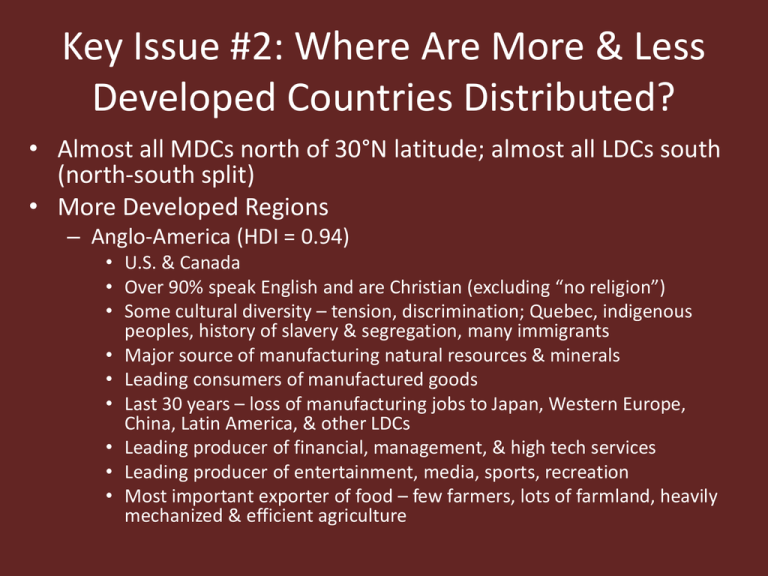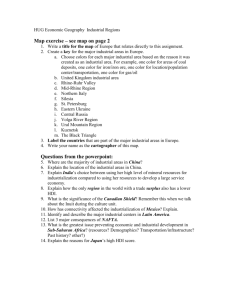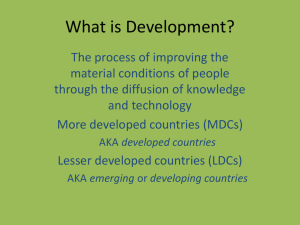Where Are More & Less Developed Countries Distributed?
advertisement

Key Issue #2: Where Are More & Less Developed Countries Distributed? • Almost all MDCs north of 30°N latitude; almost all LDCs south (north-south split) • More Developed Regions – Anglo-America (HDI = 0.94) • U.S. & Canada • Over 90% speak English and are Christian (excluding “no religion”) • Some cultural diversity – tension, discrimination; Quebec, indigenous peoples, history of slavery & segregation, many immigrants • Major source of manufacturing natural resources & minerals • Leading consumers of manufactured goods • Last 30 years – loss of manufacturing jobs to Japan, Western Europe, China, Latin America, & other LDCs • Leading producer of financial, management, & high tech services • Leading producer of entertainment, media, sports, recreation • Most important exporter of food – few farmers, lots of farmland, heavily mechanized & efficient agriculture Key Issue #2: Where Are More & Less Developed Countries Distributed? • More Developed Regions – Western Europe (HDI = 0.93) • Cultural unity with mostly Indo-European languages & Christianity • Diversity with wide range of languages, different religious practices, ethnicities; source of conflict (wars, genocide) • More unified since end of WWII (EU) • Diversity increased by migration of Muslims & Hindus from LDCs • NIR at or below 0; immigration is responsible for pop. Growth • Highest HDI in core (Germany, NE France, N. Italy, Switzerland, S. Scandinavia, SE U.K., Belgium, Netherlands, Luxembourg) • Lower in periphery (S. Italy, Portugal, Spain, Greece) • Must import food, energy, & minerals (once relied on colonies) • Provide insurance, banking, luxury cars (BMW, Mercedes, etc.) • EU – removal of economic barriers, richest market in world Key Issue #2: Where Are More & Less Developed Countries Distributed? • More Developed Regions – Eastern Europe (HDI = 0.80) • Only region where HDI has declined since 1990 (legacy of Communism) • About equal with Latin America since 2000 • East of 15°E longitude – under USSR influence until early 1990s • Albania, E. Germany, Hungary, Czechoslovakia, Bulgaria, Poland, Romania, Yugoslavia, former Soviet republics in Europe • Rapid development under Communism in 1950s & 60s • Gosplan (planning commission) – developed 5 year plans in USSR that focused on: – heavy industry (steel, iron, weapons, oil) & mining, electric power, transportation – dispersal of industry (move to Asian portion to give safety & redistribute wealth) – Locate near raw materials not markets (efficient to produce heavy industry but lack of consumer demand in Siberia) Key Issue #2: Where Are More & Less Developed Countries Distributed? • More Developed Regions – Eastern Europe (HDI = 0.80) • Communism ended due to desire for freedom & because central economic planning proved disastrous – Annual targets met but long-term investments/upgrades ignored – Inefficient agriculture (had to import) – Factories often did not implement orders (long-distance & unmonitored) – Some targets unrealistic; others were ignored to ensure job security – Heavy pollution & little environmental standards • Neglected consumer products (autos, fridges, clothing) – but people saw them on TV, movies, radio (better life in West) • Housing shortages, poor living conditions Key Issue #2: Where Are More & Less Developed Countries Distributed? • More Developed Regions – Eastern Europe (HDI = 0.80) • Border countries to Western Europe have grown more rapidly economically (Czech, Hungary, Poland, Slovakia, Slovenia) • Russia’s HDI is lower than Libya & Malaysia (as of 2005); declining HDI in former Soviet states – high death rates, lower production, possibly falsified statistics under Communism • Closed inefficient businesses; increased unemployment, price for goods increased with removal of gov’t subsidies Key Issue #2: Where Are More & Less Developed Countries Distributed? • More Developed Regions – Japan (HDI = 0.94) • Anglo-America & Western Europe are more alike & viewed together by much of the world (“the West”; history of global dominance) • Japan is a 3rd center, with a very different culture • Very few resources, but a very large population – High physiological densities & intensively farmed lands – Consume little meat (other than fish) & little grain (other than rice); must import most of food – A leading steel producer; must import all coal & iron ore – Large # of people willing to work for lower wages – Sell products at lower prices in foreign markets – Also produce high quality, high value products (electronics, cameras, autos) – Concentrated on education & training for skilled labor force – Spend 2x on what U.S. companies spend on research & development Key Issue #2: Where Are More & Less Developed Countries Distributed? • More Developed Regions – South Pacific (HDI = 0.87) • Australia & New Zealand & several small islands/island groups • Small population & remote – not as important to global economy • Becoming increasingly connected to Japan & other Asian countries • Australia & NZ (former British colonies) have high HDIs and export food to U.K. • Smaller islands are less developed Key Issue #2: Where Are More & Less Developed Countries Distributed? • Less Developed Regions – Latin America (HDI = 0.80) • Mostly Romance languages (Spanish & Portuguese) & Roman Catholic • Diversity with indigenous people pop. & history of slaves brought from Africa • Very Urbanized compared to other LDCs • Mexico City, Sao Paulo, Buenos Aires in top 10 largest cities in world • Concentrated near Atlantic coast – export to Europe during colonial era, mountains & rain forests limited access to interior • Higher HDI along coast from Argentina to Brazil & in Mexico (Mexico very close to U.S.); higher in Chile also (many exports) • Lower HDI in Caribbean, Central America, & interior South America • Biggest hindrance to development – inequitable income distribution (a few wealthy families & many very poor); many tenant farmers (cash crops such as coffee, tea, fruit – but not for local consumption) • Encouraged redistribution of land & wealth but do not wish to alienate wealthy landowners; many poor were given low quality land Key Issue #2: Where Are More & Less Developed Countries Distributed? • Less Developed Regions – East Asia (HDI = 0.76) • China – 2nd largest single economy behind U.S.; 1/3 of world’s economic growth; fastest growing GDP per capita in the world; world’s most populous country • China’s economy was wealthiest until 1500s; economy has fallen behind by foreign invasions, imperialism, & civil wars • 1949 (Communism) – focused on rural areas (2/3 of pop.); gov’t took over land (communes) & controlled production; food grown for local consumption (not export); recent changes to allow for land ownership • Dramatic increase in manufacturing – largest workforce & largest market for consumer goods • Lower wages than MDCs (produce for local use & export) • Partner with major companies like Wal-Mart (prices & wages worldwide kept low) • Regional inequality – higher GDP near coasts (Beijing to Shanghai has ¼ of pop. & ½ of GDP & ¾ of foreign investment) • Problems: weak middle management, low quality control, primitive banking, inadequate legal protection, pollution, rapid development strains resources • Largest consumer of copper, steel, cement & 2nd largest of oil behind U.S. Key Issue #2: Where Are More & Less Developed Countries Distributed? • Less Developed Regions – Middle East (HDI = 0.68) • Southwest Asia & North Africa; dominated by desert, Arabic, & Islam • Most products must be imported (particularly food) • Large % of petroleum reserves – only region that enjoys a trade surplus (imports > exports); other regions buy oil from Middle East • Some countries lack significant oil reserves (Egypt, Syria, Jordan, Israel, Lebanon); most oil is found near Persian Gulf • Oil has led to conflict: 1990 – Iraq invaded Kuwait (large reserves) & accused Kuwait of not sharing wealth & not providing good living conditions for Arab guest workers; Iraq’s largest oil fields also lie under Kuwait • Major challenge – to promote development while maintaining Islamic traditions – Role of women in business is restricted – Low literacy rate of women – Prevent financial/lending practices that are incompatible with Islam Key Issue #2: Where Are More & Less Developed Countries Distributed? • Less Developed Regions – Middle East (HDI = 0.68) • ADHI (Alternative Human Development Index) – UN developed to calculate HDI when adjusted for social inequality (ethnicities, religious, social class, gender, etc.) – 3 reasons for low HDI in Middle East: » Lack of political freedom » Low education & literacy rates » Lack of opportunities for women • Internal conflicts – Iraq, Iraq vs. Iran, Shi’ite vs. Sunni, Syria, Kurds, Israel, Palestine, Lebanon, Libya, Tunisia, Egypt • Most Arab & Muslim states refuse to recognize Israel • Many spend money for war rebuilding & military than economic development • Terrorism – most do not hate it, most do not endorse it either • Most did not support U.S. invasion of Iraq in 2003 & do not support the “War on Terror” Key Issue #2: Where Are More & Less Developed Countries Distributed? • Less Developed Regions – Southeast Asia (HDI = 0.58) • Indonesia – 2/3 of pop. on Java • Vietnam, Thailand, Philippines • Internal conflicts, wars, colonialism by Japan/Netherlands/Portuguese/U.S./U.K./France • Tropical climate - soil & climate not good for most grains (low nutrients, excessive water) • Mountains, volcanoes, rainforests, typhoons, tsunamis all challenge economic development • Medicines & tech led to pop. Growth • Most crops based in manufacturing – palm oil, coconut oil, rubber trees, kabok (fiber used in insulation), abaca (used for rope fibers) • Major food & export crop is rice (Indonesia, Malaysia, Thailand, Vietnam) • Rapid development in Thailand, Singapore, Malaysia, & Philippines (textiles/clothing – due to low cost labor) • Economic growth has slowed recently – unwise investing, lack of watchdog groups, reforms are in process but expensive & time consuming Key Issue #2: Where Are More & Less Developed Countries Distributed? • Less Developed Regions – South Asia (HDI = 0.58) • • • • • • • • • • India, Bangladesh, Pakistan, Sri Lanka, Nepal, Bhutan Region with 2nd highest pop. & 2nd lowest per capita GDP High NIR, high pop. Density Climate – monsoon rains May-August (varies year to year) India – jute (rope, twine, burlap), peanuts, sugarcane, tea, uranium, bauxite (aluminum), coal, manganese, iron, chromite, rice, wheat, cotton India has many minerals but a low mineral to pop. Ratio Green Revolution (since 1960s) – dramatic increase in agricultural production with genetically engineered seeds, improved farming practices, more chemicals & machines India – 4th largest total GDP behind U.S., China, Japan; but low per capita Manufacturing growth but not as fast as China Service sector growth with help desks – credit card, airline, tech, etc. Key Issue #2: Where Are More & Less Developed Countries Distributed? • Less Developed Regions – Sub-Saharan Africa (HDI = 0.51) • Lower pop. density than other LDCs • Major source of minerals: – – – – – South Africa – chromium, gold, diamonds, manganese, platinum Botswana & DRC – diamonds Guinea – bauxite; DRC & Zambia – cobalt Gabon – manganese; Nigeria – petroleum Niger – uranium • Main problem – inability of land to provide food/resources for the rapidly growing pop. (deserts & tropical climates; highest NIR; overworked land (desertification)) • Least favorable development prospects: – Highest % in poverty – Poor health & education – Weakening economic conditions (avg. African consumes less than 25 yrs ago) • Legacy of colonial era – goods produced for export not local use, border disputes, ethnic conflict, landlocked states Key Issue #3: Where Does Development Vary by Gender? • Using total figures masks gender inequality • UN states that gender equality exists in every country to some extent • GDI (Gender-related Development Index) – compares women with both sexes combined • GEM (Gender Empowerment Measure) – measure ability of women to participate in economic & political decision making • GDI (measures standard of living of women vs. men) – Similar to HDI (1 economic, 2 social, 1 demographic) – Penalizes large disparities between men & women (Ex. Iran & Mexico have even % of kids enrolled in school but GDI is much higher in Mexico because girls are more likely to be enrolled in school) – Total equality = 1.0 (no countries) – Highest in 2005 – Norway (0.96) – Often higher in Western Europe & North America – Lowest in Sub-Saharan Africa – Often low in Middle East Key Issue #3: Where Does Development Vary by Gender? • GDI – Economic Indicator of Gender Differences (Average Income) • • • • Average Income – lower in every country for females U.S. in 2010 - $42,800 (male) vs. 34,700 (female) Women make 2/3 male income in MDCs (avg. gap of $12,000) Higher % difference in LDCs – Social Indicators (Education & Literacy) • LDCs – women less likely to attend schools (especially high school and beyond) • MDCs – 99 girls to 100 boys; LDCs 60 girls to 100 boys • Very low in Sub-Saharan Africa & Middle East (fewer than 1/3 of girls attend school) • Universally required school attendance in MDCs • Latin America & Asia have equal attendance by gender, but lower overall attendance • Literacy – MDCs (near equal & very high); Latin America & Asia (near equal, but not as high); Sub-Saharan Africa (low for both, but lower for female) • Low education & literacy limits ability of women to participate economically & politically in some parts of the world Key Issue #3: Where Does Development Vary by Gender? • GDI – Demographic Indicator (Life Expectancy) • MDCs – life expectancy is several years longer for females (6 years in U.S.) • LDCs – only 1 -2 years longer for females • Lower in LDCs due to hazards of childbearing (poor medical conditions) – Overall, the status of women is improving around the world • Gender Empowerment (GEM) – Measures ability of women to participate in improving quality of life – In every country (MDC or LDC), fewer women hold positions of power – GEM calculated using income & professional jobs (economic power) and managerial jobs & elected jobs (political power) – Complete equality = 1.0 (no countries at perfect GEM) – Highest in N. America, Northern Europe, & South Pacific – Lowest in Africa & Asia – Difficult to determine accurately due to limited data in LDCs Key Issue #3: Where Does Development Vary by Gender? • Gender Empowerment (GEM) – Economic Indicators (Professional Jobs & Income) • Cultural barriers restrict empowerment of women in professional & technical jobs • ½ or more of professional/tech workers in N. America & Northern Europe are women • Less than ½ in LDCs (where data is available) • Share of income is lower in every country (gender wage gap) – Political Indicators (Managerial Jobs & Elected Jobs) • 1/3 of managerial jobs held by women in N. America, Northern Europe, & South Pacific • Less than ¼ in LDCs where data available • Elected positions – no female majority in any country; highest in Northern Europe (about 1/3) • About 1 in 5 elected officials are women in other MDCs (15% in U.S. House & Senate) • Less than 1 in 10 elected officials are women in LDCs • Every country has a lower GEM than GDI – women hold a greater share of resources compared to their power to allocate resources



